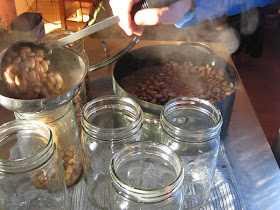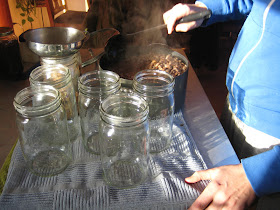Fast forward 30(ish) years and you'd find me cleaning beans, soaking them overnight and then cooking them on the stove top for an eternity. Almost quite literally. At our altitude (almost 7000 feet), dried beans can take all day to cook.
While it was great to have our own fresh beans, when something takes you a day and a half to make, you want to keep it around, right? So, we started freezing batches of beans for later convenience. Gross. They get freezer burn quickly and turn quite mushy. I don't recommend it.
Hmmm...enter the Pressure Canner! We got this guy at the end of 2011 (December 27th, I think) and have been playing with him ever since!

Now, please don't think there wasn't some hesitation...there certainly was...and still is. This guy feels quite... intimidating. Size, bolts, weight, it's ability to crush small objects. Right. Anyhow, by reading and re-reading the instruction manual, and keeping it very close (still) while canning anything, we've pulled off a couple of great batches of beans and various veggies! My favorites so far being beets and beans! Really and truly, once you can your own beans, you will never eat them out of an aluminum can again! The taste is amazing, and the savings are substantial (especially once you start re-using your jars)!
Alright, enough chatter! Let's can some beans! We use the quart size jars because they are perfect for feeding our family of 3 (2 adults and one teenager). A quart of beans will make 3 big burritos or about 6 smaller, side-sized portions.
To start, take your dry beans and weigh them. A little less than half a pound will make one quart of beans. Let's say 6 ounces.
Next, clean your beans. Dump them out on your counter and go through them all a few at a time. Put the good beans in a bowl or colander and separate out the bad beans and any rocks you find.
Bad beans will be discolored, shriveled or just plain gross looking. Without a doubt, you will always find at least one rock in your dried beans, making it imperative that you do not skip this step! Broken teeth are not fun. Period.
Next, rinse your beans under running water and place them in a pot of water to soak for a few hours (4-10 is great - I usually start this process in the morning, then can them in the afternoon). This helps them soften up and release some of their gases. Your belly and your family will be grateful for this step, trust me.
While your beans are soaking you can sterilize your jars and utensils. (I have read that this step isn't necessary when pressure canning, but it makes me feel better to complete this step anyway.) My dishwasher is my best friend when it comes to this job...just don't ever put your lids in the wash, they'll lost their ability to stick properly. Those should be washed by hand with warm-ish to hot water.
Then, place your pot on the stove and heat your beans until their almost boiling. This allows you to hot pack your beans. You're not "cooking" them, just heating them up.
Ladle your beans into your quart jars until each jar is about 3/4 full...

Linking up to Frugal Days, Sustainable Ways #16








Cool :) - thanks for all the detail. When I finally get a pressure cooker I'll now know how to preserve my beans :)
ReplyDeleteYou're welcome, Dani! I hope you get a pressure canner soon! They're really like magic!
DeleteMy very first canning adventure with my pressure canner was pinto beans. They were a surprisingly big hit, and remain my most popular canned food. I made them on a whim only to find that we couldn't do without them, now. Yours are beautiful! Looks like you didn't make my rookie mistake of putting too many beans in the jar. When canning beans you must use less food and more liquid than with other canned foods. I found that one out the hard way:(
ReplyDeleteYes! Canned beans are awesome! I've been asked "why can them when they keep so well dry?", but I've found it saves so much time and energy! And, they're SO tasty :-)
DeleteI'm just learning regular canning, the pressure canning does seem a bit intimidating. We love beans, so this might be inspiration to overcome that fear of losing a limb or something, LOL! We use a pressure cooker all the time and don't even think twice, i'm supposing it's just the size of that bad boy that makes it a bit scary. Thanks for taking the edge off! And they look beautiful!
ReplyDeleteHappy canning! You'll do just fine, I'm sure!
DeletePressure cookers are great. They really make foods convenient. I've recently decided to change up the 2012 garden plans a bit. Instead of having 300SF of Corn there will be beans there instead. We eat that much more than corn. I'll find another special spot for the Corn though. :)
ReplyDeleteIt's such a balancing act, isn't it?! I love corn, too and always find space for it, but it does take up a lot of space for little yield! Have you tried growing beans and corn together? They do really well! I prefer to grow bush beans with corn instead of pole beans :-)
DeleteI also can up "Re-fried" beans this way. I place a 1/4 cup diced onion and one clove of garlic in to each jar and all the rest of the spices go into the pot with the beans. Bring to a boil and fill the jars with the beans (for quarts, I use 1 3/4 cups of beans) then top off each jar with the cooking water.
ReplyDeletePressure can quarts for 90 min at 10 lb pressure.
That sounds delicious! What other spices do you add?
DeleteWhat spices did you use?
DeleteWe bought that same canner last summer and LOVE it. A solid piece of American workmanship. With those screws, I feel safe that it's not going to send the lid twirling across the kitchen at 100 miles an hour. :-)
ReplyDeleteHa! Yes, the screws are the best, aren't they?!
DeleteI love the look of your home-canned beans! Thanks for the wonderful tutorial!
ReplyDelete-Jaime
Thanks, Jaime! There's no comparison to store bought!
DeleteI wish I'd planted more drying beans this year - oh well there's always next year - your canned beans look great, but I'm still too scare of pressure cookers/canners to consider then. Perhaps when I get over my maternal paranoia.....
ReplyDeleteOh Liz! Do it! It will work out just fine as long as you follow the directions! It's so worth a little bit of stress in the beginning to be able to put up SO MANY different foods :-)
DeleteI wish I knew more about this beans process but my sister cans loads of stuff, including dry beans. I help; but I have a ceramic top stove, sigh.. No big canner for me at this time. I do have one that does pints and that is ok for the stove. At any rate. She (my sister)cleans and puts her beans in dry with seasonings and water and then pressures them... Just courious what and how the differetnces would be. They work for me exactly like the comercial caned beans.. Love that! Also when she cans and has a space or two left she cans a quart of water. Just tap water. then there is safe long term water on the shelf. I thought that was kind of cool.. brilliant. How ever we have tons of jars from mothers canning stash. She had about 3-4 jars for every day of the year. We canned every thing from soup to nuts so to speek. Fish, meat, veggies, fruits, pickles, in any kind of combinanation and recipie imaginable, we still use some of Grand and Great Grandmothers canning recipies. Grand Can are us! Love it! - it is so rewarding and all kinds of fun when you work with some one that makes it fun.. Plus if you are with out power for a length of time you loose frozen goods. Caned goods are there for a long long time.. happy eating!
ReplyDeleteThe only difference between putting them in dry and soaking them first is that the soaking process allows the beans to release some of their gases, which makes for a happier tummy later ;-) I love the 'canning water' idea! That is brilliant! I just might have to try it! It sounds like you have kept up with a beautiful family tradition...and how lucky you are to have your grandmother's recipes! I am starting from scratch, literally (no one in my family has ever canned anything), but hope to hand down some information to my daughter and any grandchildren I might wind up with :-)
Delete